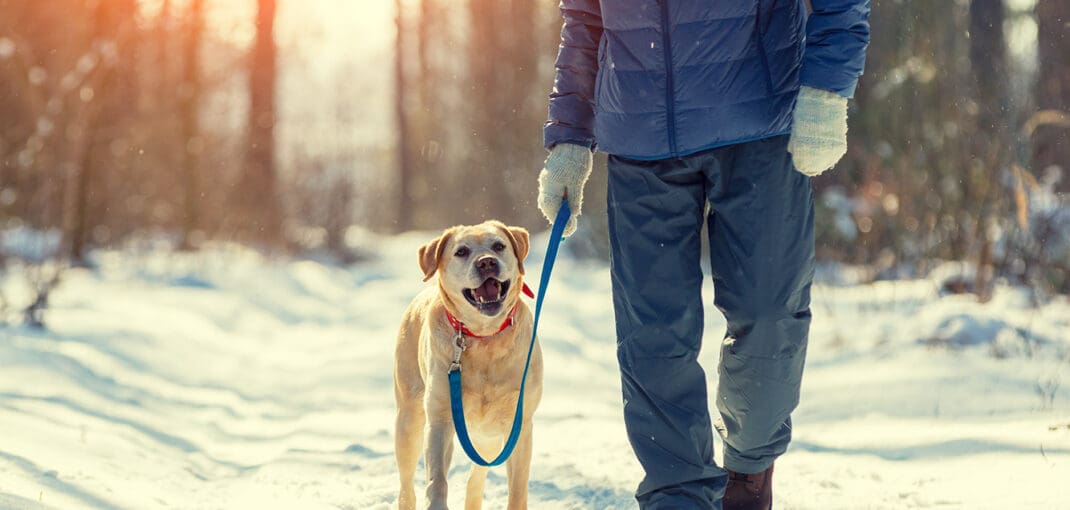In today’s world, the pace of life is very fast and this has an impact on our emotions. More stress, less time for our human needs. During walks, our dog gets to know the world with his nose, he can not only sense the state of health but also our feelings. Therefore, we need to remember that the mood of the guardian or handler can affect the walk, training and life with the dog.
The tone of voice and the way we speak to the dog
Often we may find that our pooch is agitated from just leaving the house and cannot calm down. Unfortunately, it happens that we are the cause of this emotional state. In order to signal our pet to go for a walk, we say to it in a high or even squeaky voice word like “Shall we go for a walk? Who’s going for a walk?”.
Let’s just try to put a harness or collar on the dog, attach the lead and go out for a walk.
The handler gets scared and now what?
We may come across the opinion that, in order to help the dog calm down on a walk, we should provide social support, such as crouching down next to the pet or calmly stroking it around the shoulder blades.
And yes this does work, but sometimes we need to walk a bit further away for the dog to benefit from this. However, we should first calm our emotions, which is not always easy.
Imagine a situation in which our dog barked at a neighbour or another dog. Our emotions at such moments are not positive, we become upset and stressed ourselves. In such an emotional state, we have no way to help our dog. We can say to him “words like, nothing happened, I understand that you are afraid”. And this is a good method but not when the carer or the dog is stressed, at the same time stroking him, however, doing this in a high stress, will not calm him down. In order to understand our pet, we must first let it go and calm our own emotions. This is not easy, but without this, social support simply will not work.
This does not only apply to fear of aggression towards people or other dogs but also, for example, to hypersensitivity to noises or sounds. If we want to help our pet during New Year’s Eve, we should first help ourselves. Probably all of us have heard the saying that a good rescuer is a live rescuer. We can also use the same with the support of a dog! A good handler is a calm handler.
The gaze and body posture of the handler and the behaviour of the dog
When talking about emotions, we rarely think about what effect someone’s gaze can have on them. It is hard to put it all together. However, if we think about how we can feel depending on how someone looks at us, the situation brightens up for us.
Let’s imagine a situation where a dog has taken our sock. By focusing our gaze on it, we suggest that it is an important thing to us. By approaching the pet, we show that we want it back. If there is space, the dog will want to leave, if there isn’t, it will usually ball its ears and, in extreme cases, there may be a defence of the item in question that the dog holds and which it does not want to give up. In such situations, both we and our pet are charged with negative emotions.
By focusing our attention on another object, we focus the dog’s curiosity not on the prey, but on something else. This is social learning that can be easily observed. A dog that does not want to come because it is doing something important. Just crouch down and start playing with something on the ground. For the dog, this will be interesting enough that he will let go of his thing to see what his handler has found that has made him so curious so that the pet comes to us intrigued and calmer. At such a time, he will leave the previously captured object and retrieving it will not involve negative feelings.
Behaviour and emotions in a dog are not only influenced by our gaze. The positioning of the whole body is also important! And what we communicate to our pet non-verbally translates into his emotional state, arousal, as well as stress level in his body.
Dogs communicate with us non-verbally, through body language and social learning. If our dog is afraid of the other dog and I, as the handler, being positioned frontally to him then my dog will be obliged to approach him.
Summary
A dog’s emotions are not only influenced by the way we communicate with them verbally, but also non-verbally. Let us remember that our body or gaze should not put undue pressure on the pet. Let us be a good, calm guide for him and this will be the start of good changes.






